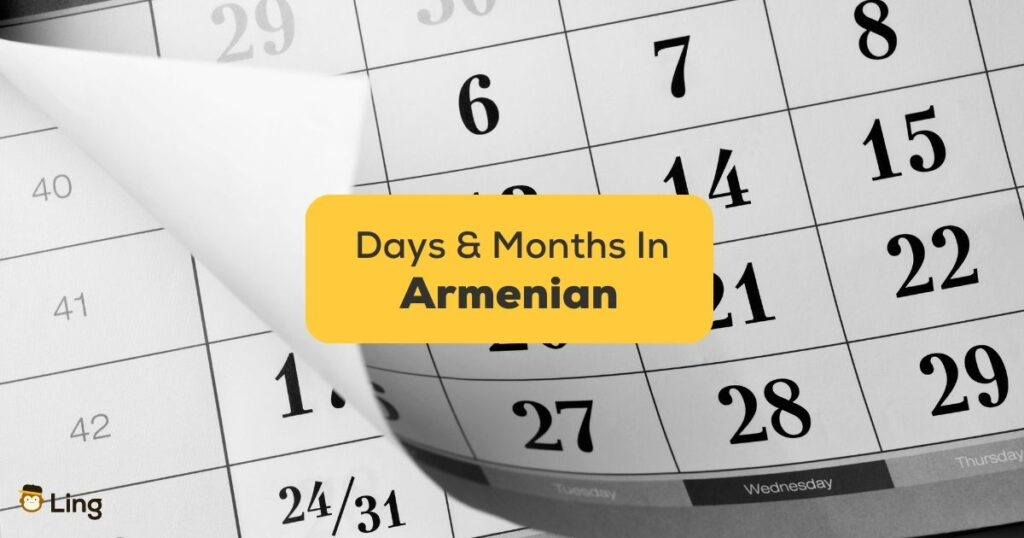Ever felt like time has a flavor of its own? A dash of Monday blues, a sprinkle of Wednesday wisdom, and a dollop of Friday fun? Well, buckle up, dear reader, because you’re in for a treat! In this wild ride of an article, we’ll go over the super easy, totally not boring words related to Armenian days and months in the calendar. This ain’t just another snooze-fest of words to cram. Nah, this is actually the golden ticket if you want to avoid those awkward “I thought it was Tuesday” mishaps during your epic Armenian adventure or those cringe-worthy pauses when chit-chatting with native speakers. Let’s begin!
The Armenian calendar, traditionally used in Armenia during the medieval ages, is quite distinct in its structure. It is based on an invariant year length of exactly 365 days. However, due to the fact that a solar year is about 365.25 days, not precisely 365, the Armenian calendar’s alignment with both the solar year and the Julian calendar shifted over time. This shift created a one-year difference over a span of 1,461 calendar years, a phenomenon related to the Sothic cycle.
In A.D. 352, Armenia implemented tables compiled by Andreas of Byzantium to determine religious holidays. When those tables were exhausted on 11 July 552 (Julian Calendar), the Armenian calendar was introduced.
Today, the Armenian calendar features analytical expressions, including ancient names of days of the week, Christian names of the days of the week, days of the month, the Date/Month/Year number after 552 A.D., and the religious feasts. It consists of 12 months with 30 days each and an additional (epagomenal) five days called aweleacʿ (“superfluous”).
If the Armenian calendar is pretty tricky, then why should you bother learning it, right? Let’s answer that and more in the section below.
Why Bother Learning About Armenian Days And Months?
Why should anyone take the time to learn about Armenian days and months? It’s a valid question, and the answer goes beyond mere curiosity. Here’s why diving into this topic can be both fascinating and practical:
- Cultural Insight: Understanding the Armenian calendar system offers a glimpse into the country’s rich history and cultural traditions. The names of the days and months, along with the way they are used, can reveal fascinating aspects of Armenian identity and heritage.
- Language Proficiency: If you’re studying the Armenian language or planning to visit the country, knowing the terms for days and months is essential. It’s not just about booking travel or scheduling appointments; it’s about immersing yourself in everyday conversations and local customs.
- Business Etiquette: For professionals engaged in business with Armenian counterparts, understanding the local calendar can enhance communication and collaboration. It’s a sign of respect and can lead to a more harmonious working relationship.
- Academic Interest: Scholars of linguistics, history, or anthropology might find the Armenian calendar system a valuable subject of study. It can contribute to broader research on timekeeping methods, regional variations, and the interplay between culture and chronology.
- Personal Enrichment: Lastly, learning something new and unique always adds to personal growth and intellectual enrichment. Whether you have Armenian ancestry or simply love exploring different cultures, this knowledge can be a satisfying addition to your mental library.

Armenian Days Of The Week
Armenia, with its rich cultural heritage and unique language, follows the standard seven-day week structure. Yet, the names of the days are distinct, mirroring the historical and religious influences within Armenian culture. Whether you are planning a trip, conducting business, or simply expanding your linguistic knowledge, understanding the Armenian days of the week can be both practical and intriguing.
Here’s a table showcasing the English and Armenian translations, along with the Armenian pronunciation:
| English | Armenian Script | Armenian Pronunciation |
|---|---|---|
| Monday | Երկուշաբթի | Yerkushabti |
| Tuesday | Երեքշաբթի | Yerekshabti |
| Wednesday | Չորեքշաբթի | Chorekshabti |
| Thursday | Հինգշաբթի | Hingshabti |
| Friday | Ուրբաթ | Urbat |
| Saturday | Շաբաթ | Shabat |
| Sunday | Կիրակի | Kiraki |
To integrate the Armenian days of the week into everyday conversation, it’s crucial to familiarize yourself with some basic sentence structures. Here are some foundational patterns:
- Today’s Day:
- English: Today is [Day].
Armenian: Այսօր [Day] է։
Pronunciation: Aysor [Day] e.
- English: Today is [Day].
- Activity On A Specific Day:
- English: I have a meeting on [Day].
Armenian: Ես ունեմ հանդիպում [Day]-ին
Pronunciation: Yes unem handipum [Day]-in.
- English: I have a meeting on [Day].

Armenian Months Of The Year
The Armenian calendar has twelve months, similar to the Gregorian calendar. These months reflect a rich cultural and linguistic heritage. Knowing the names of these months is essential if you are looking to understand the Armenian calendar system or communicate about dates in Armenian.
Here’s a tabulated view of the months in Armenian compared to English:
| English | Armenian | Armenian Pronunciation |
|---|---|---|
| January | Հունվար | Hoonvar |
| February | Փետրվար | P’etrvar |
| March | Մարտ | Mart |
| April | Ապրիլ | April |
| May | Մայիս | Mayis |
| June | Հունիս | Hoonis |
| July | Հուլիս | Hoolis |
| August | Օգոստոս | Ogostos |
| September | Սեպտեմբեր | September |
| October | Հոկտեմբեր | Hoktember |
| November | Նոյեմբեր | Noyember |
| December | Դեկտեմբեր | Dektember |
Understanding how to incorporate the names of months into sentences is an important step in effectively communicating in Armenian. Whether you’re planning a visit, engaging in business, or simply communicating with Armenian-speaking friends, here’s how you can use the names of months in common sentence patterns:
- Stating Your Birth Month:
- English: I was born in April.
Armenian: “Ես Ապրիլին ծնվել եմ։”
Pronunciation: Yes Aprilin tsnvel em.
- English: I was born in April.
- Talking About Weather:
- English: It’s usually cold in January.
Armenian: Հունվարին սովորաբար սառը է
Pronunciation: Hoonvarin sovorabar sarə ē.
- English: It’s usually cold in January.
- Planning A Meeting:
- English: Our meeting is scheduled for October.
Armenian: Մեր հանդիպումը հոկտեմբերին է պլանավորված։
Pronunciation: Mer handipumə hoktemberin ē planavorvac.
- English: Our meeting is scheduled for October.
- Discussing Events Or Holidays:
- English: Independence Day is in September.
Armenian: Անկախության օրը Սեպտեմբերին է։
Pronunciation: Ankakhutyan ore Septemberin ē.
- English: Independence Day is in September.
- Expressing Preferences:
- English: I love the flowers in May.
Armenian: Ես սիրում եմ Մայիսի ծաղիկները։
Pronunciation: Yes sirum em Mayisi tsaghiknery.
- English: I love the flowers in May.
Learn Armenian With Ling
So, you’ve dipped your toes into the enchanting world of the Armenian language, exploring days and months. Feeling inspired to dive in deeper? Trust me, there’s so much more to learn and enjoy.
Here’s the deal: If you’re serious about learning Armenian, you’ve got to try out the Ling app. Whether you’re a complete beginner or just looking to brush up on your skills, Ling has got you covered. It’s available on both the App Store and Play Store, and it’s packed with engaging lessons, quizzes, and native speaker recordings to guide you along the way.
Why stumble around in the dark when you can have a tailored learning experience at your fingertips? Download the Ling app today, and embark on an exciting language journey. Armenian awaits you!



































































